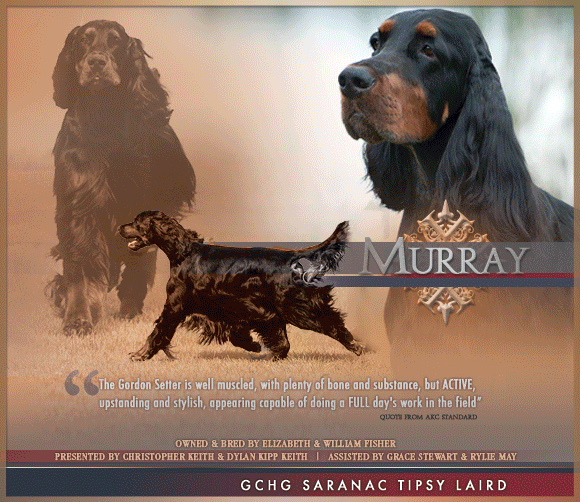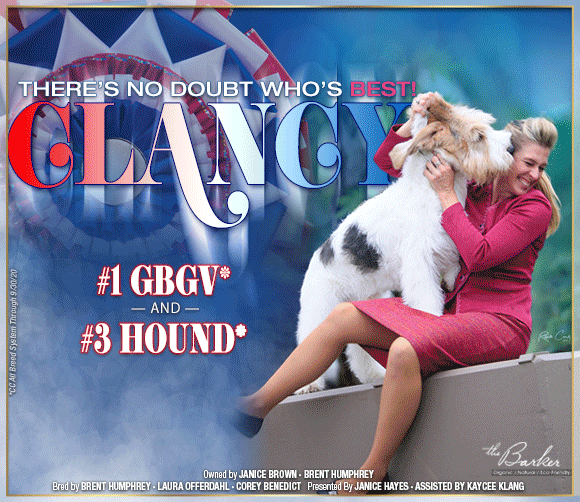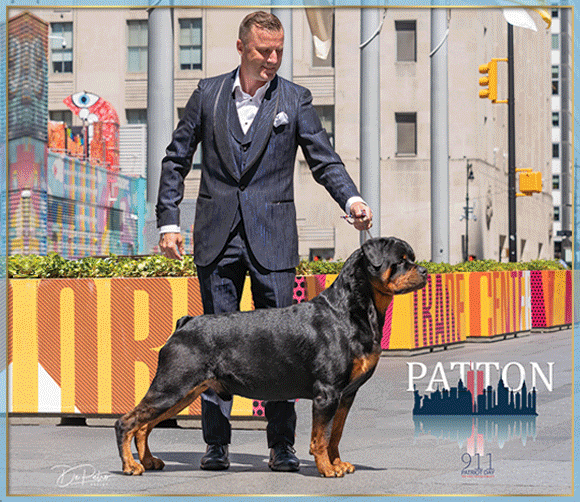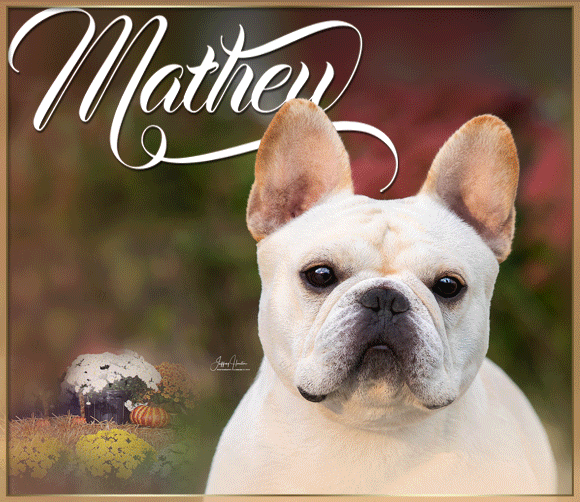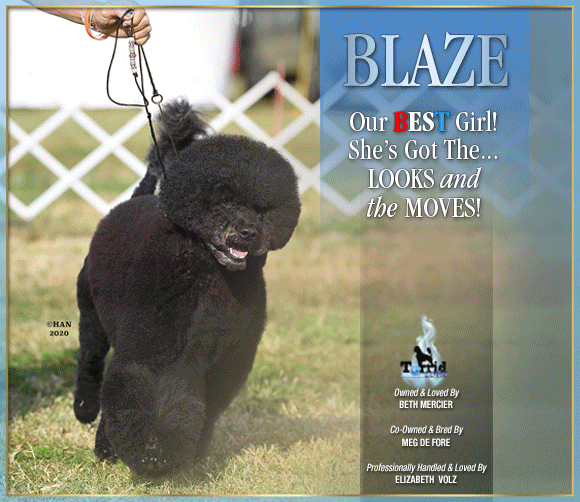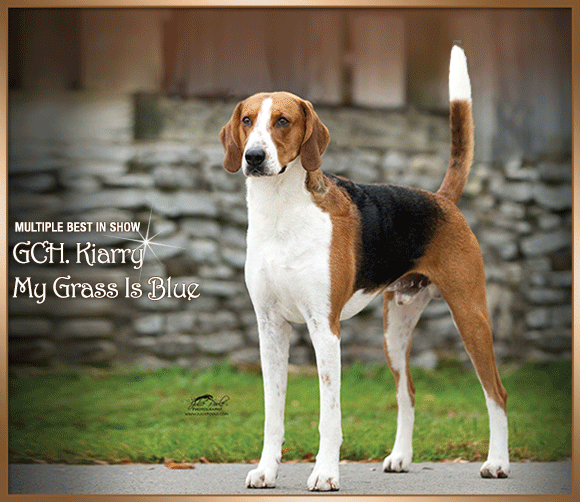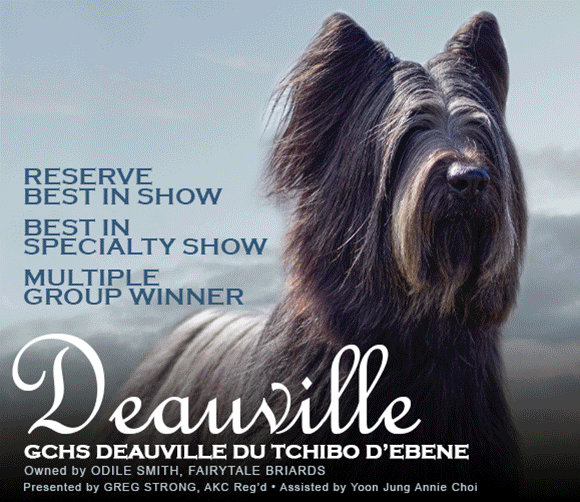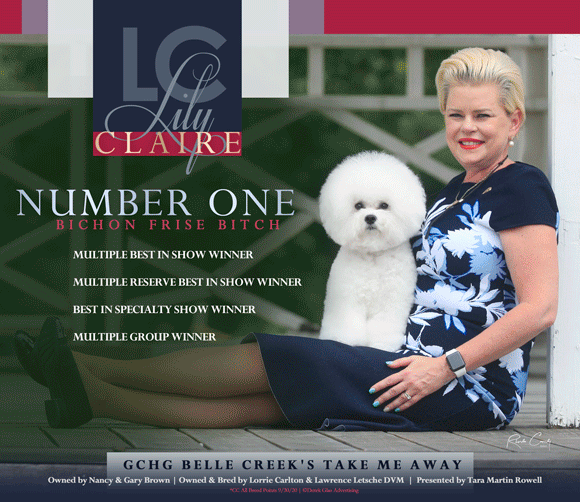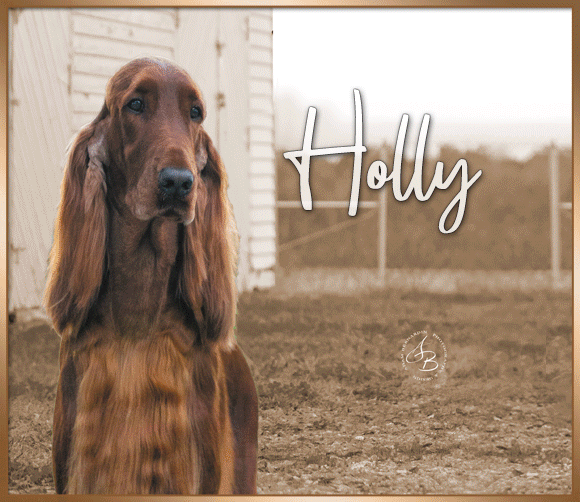Ernest Huntley Hart – Artist Extraordinaire
From the archives of The Canine Chronicle, August, 2013
Click to Read more at 146 – August, 2013
By Amy Fernandez
Although Leon Whitney was 15 years older than Ernie Hart their lifetime friendship ultimately produced two generations of innovative contributions to the dog world.
When Whitney moved his family to Orange, Connecticut in 1930 it was all about location. Then a tiny rural farming community, Orange was conveniently close to New Haven and Yale. It offered access to cutting edge research and space for his growing kennel. In his 2007 blog, son George describes one of his father’s most ambitious projects, which commenced soon after their arrival. “With the ever-growing numbers of dogs came the expense of feeding so many. At that time there was no completely balanced dog food …“So what to do? The answer was simple, compound one ourselves.” Anticipating the scope of this venture, Whitney constructed an enormous garage with an oil stove and floor to ceiling shelves filled with wire bottom cages. “In those days there was no balanced ration for any animals other than for rats and mice.” Whitney’s garage became a laboratory. “Then came the white, pink-eyed laboratory rats. …It was my paid job to care for the 200 or so rats. Food and water daily and clean the cages weekly. The salary was $1 a week.”
By then, Whitney had bred dogs for two decades. Commercial dog food had been around since the late nineteenth century but few people trusted it, for good reason. Its composition and nutritional value remained anyone’s guess. This was attributable to several factors, but the biggest was the scant information then available about human or canine nutritional requirements. That didn’t imply lack of interest. For centuries, it was obvious that dogs required certain foods. Discoveries in this area dated back to the late 1700s, but genuine progress had to wait for 20th century advances in biochemistry. That made it possible to identify chemical compositions of foods and study the quality and amounts of specific components essential for health.
In January 1936 the AKC Gazette announced a major breakthrough. “Until comparatively recently, the average dog fancier had never heard of a vitamin – yet of late we have become vitamin conscious…yet, in the layman’s mind there is still quite a bit of confusion as to just what a vitamin is, what it does, and where it may be found.”
By 1930, much of this research was happening at the Connecticut Agricultural Experiment Station (CAES), America’s first government-funded public laboratory. Founded in 1875, prior to the advent of food and drug safety regulations, the Station not only analyzed soil and fertilizer samples for local farmers, it provided tox testing for Connecticut residents justifiably concerned about ingredients in their food, water, and drugs.
Concurrent research at the Station and Yale’s Sheffield Scientific School nearby led to several crucial discoveries. Rat and mouse feeding trials consistently demonstrated that formulations of protein, carbs, fats, salt and water caused several dietary deficiencies. Obviously, crucial elements were missing from this mixture, but that remained speculation until biochemical research at the Station began focusing on the composition of plant proteins. This led to research on essential amino acids and that was the key to a central concept of nutrition. The Station was paradise to someone like Whitney. George recalls accompanying his father on frequent visits to utilize its lab services and hang out with the researchers. And right around this time, the biggest break in this field happened right there, the discovery of the first documented vitamin, which they dubbed fat-soluble A.
Whitney avidly followed this research, adding it to his growing stockpile of theories. In 1971 he wrote, “Many of my observations were made on dogs used in nutritional research. Over 12,000 puppies have been born in my kennels, mostly for nutritional research studies. One would have to be blind not to have made some useful observations.”
According to George, his father questioned many popular misconceptions of that era. “Questioning the knowledge of that time that dogs could not tolerate much fat in their diets, Dad wondered about that idea when he knew dogs often killed animals such as woodchucks and ate the whole animal including the fat.” Whitney began tinkering with a commercial rat food formula. “Soon we had a rat food that would grow rats twice as fast as and healthier than the commercial rat food….The next step was adapting this formula to create a dog food. …It amounted to a self-learned home-earned degree in canine nutrition.”
Delighted to get rid of it, local butchers supplied Whitney with all the beef fat he wanted. That minimized one complication, but this project redefined the concept of homemade dog food. Whitney’s mixture required 24 ingredients. George grew up learning the routine of purchasing, mixing, and storing them. “A giant pile of bread meal was piled on one side of the sanitized garage. Carefully weighed quantities of the other ingredient such as bone, fish, beef, alfalfa leaf meal on the other side. Then began a slow process of shoveling the pile from one side of the garage to the other to mix it. To be sure some of the trace elements were well-mixed required hours of shoveling back and forth. …At first we mixed several hundred pounds and eventually a thousand pounds at a time.”
The result could be classified as one of the earliest high performance formulas. Feeding trials were the next step. “The new food with fat added resulted in the healthiest looking, most active hunting dogs imaginable.” Other local kennels began requesting Whitney’s homemade food, and within a couple of years, all that backbreaking work paid off. “For a short time we donated food to a few kennel owners and the results were so outstanding a company put the formula on the market.”
Although their careers diverged, Whitney and Hart never lost touch during these years. Hart then lived in nearby New Haven with his first wife and sons, Allan and Lance. “He always did some freelance writing and illustrating,” says Lance. “About half the time he would work in New York and commute by train from Connecticut. After awhile, he got tired of that and he would go back to fulltime freelancing.” Hart’s success with funny animal comics like Super Rabbit gave way to changing consumer tastes. By the late ‘40s James Cagney, Humphrey Bogart, and Edward G. Robinson dominated the box office and true crime took center stage. Hart’s innate love of adventure had free rein. He transitioned to Goodman publications like Justice Comics and Official True Crime Cases. In 1946 he also started drawing and writing the comic book horse series Rocky Lane’s Black Jack for Connecticut-based Charlton Publishing, in Derby. That led to assignments in the hottest genre of the moment, Westerns.
Shows like Gunsmoke and Bonanza renewed America’s enduring obsession with the Old West. Hart was familiar with this theme thanks to his youthful adventures living and working throughout America’s West. In 1957, he became executive editor of Charlton’s newly launched Real West Magazine featuring stories on Indian lore, famous outlaws and gunfighters, and western movie stars. Much of the material came from historical records. This was Hart’s introduction to research, which became a valuable skill in his next career move.
Changing tastes in popular fiction was just one aspect of the America’s improving economy. During the 1940s, the commercial dog food industry exploded from a niche market into a cash cow. By then, demand for Whitney’s dog food formula attracted investors. It was put into production by Baloration in Brooklyn and was soon purchased by Tioga Mills in Waverly, N.Y. Renamed Tioga Dog food, it’s long gone, but its short, successful production run yielded royalties that covered four years of veterinary school for Whitney and his son.
In 1940 Whitney graduated from Alabama Polytechnic Institute, now Auburn’s College of Veterinary Medicine. He profiled this unique personal and professional story in the AKC Gazette that June shortly after son George returned from military service and entered Auburn. In the article, Whitney explained that his fascination with “To have lived with more than 500 cases of distemper, seen a 70 percent mortality rate, dug the graves for all those puppies and dogs and one day to finally realize that this is not going to be necessary in the future.”
His veterinary career coincided with unprecedented advances in nutrition, vaccine development, antibiotic therapy, diagnostics, and genetics, reinforcing his devotion to the profession. “After having bred and raised several thousand dogs , having lived with them, observed them in sickness and health, I have learned how easy it is to be mistaken in one’s diagnosis.” His background in farming and dog breeding also gave him a dual perspective. He didn’t conceal his respect and admiration for breeders saying, “many of their observations are nothing short of profound.” Whitney’s mid-life career change didn’t deter his passion for research. He lectured on clinical pathology at the nearby Yale School of Medicine until 1964, but that was just a part-time gig. “Research and application of that research will occupy my time from now on, and whatever is learned will be given to the veterinary profession. It is our earnest hope that from the Whitney Clinic will come results to help animals and humanity as well.” After graduating in 1943, George and his father established the Whitney Veterinary Clinic on their Orange, Connecticut property and maintained the practice for 50 years.
“We eventually moved out to Orange, which was very rural.” Lance was nine when his parents relocated their family to Orange to take advantage of the town’s superior school system in the early ‘50s. “We built our house at the end of the dirt road about 150 yards from the Whitney Clinic. My brother and I practically grew up there. Leon had pretty much retired and George Whitney was running the clinic by then.” Lance worked at the clinic throughout his teens, remembering George Whitney as modest, unassuming, and very friendly. He also worked for Leon, who retained his expert ability to spot ideal prospects for low wage labor. “At that time Leon was breeding racing pigeons, and he had a flock of sheep and a ram.” Whitney’s pay scale hadn’t changed much either. For years, Lance cleaned his pigeon cages for $1 an hour, slightly better than what George had received decades earlier. The monetary compensation paled in comparison to his memories of cutting across the field with a wheel barrow while dodging Whitney’s charging ram.
Inevitably, both brothers developed an enduring love for animals. Like George Whitney, Allan became interested in Beagles. Years later, in his Encyclopedia of Dog Breeds, his father proudly recounted their shared pastime. “The author, and his son, Allan, hunted, showed, kenneled, and bred specimens of this fine breed, among them the famous bench champion, Lynnlann’s Button Up, who was also a fine field trial dog and headed the kennel’s stud force.”
“I got into showing rabbits,” says Lance. During these years, his father primarily freelanced from home. “He was always in his studio working, but you could go in there anytime you wanted to talk to him or needed anything. He would do anything for you. He used to drive me all over to rabbit shows.” Hart may have moved his family to Orange for the formal education opportunities, but daily life became an equally important learning experience. Lance remembers having plenty of freedom to explore and cultivate wide ranging interests. It was a childhood that encouraged creative thinking.
During these years, Hart and Whitney not only became neighbors, they became co-workers again, thanks to one of the dog’s world’s more eccentric characters. Millions of dog lovers were introduced to their chosen breeds thanks to a TFH book, even though the company’s name made no reference to dogs. Dr. Herbert Axelrod emerged with Tropical Fish Hobbyist in 1952.
It was a spin-off of his successful tropical fish book. The sales appeal of its academic descriptions and scientific terminology defied the publishing world’s predictions. It also confirmed Axelrod’s belief that pet owners appreciated technical information, and inspired his start-up venture of pet care guides, TFH Publications. Back in the day when he was pulling this together, he needed content. That led him straight to Leon Whitney. He purchased the catalog of Whitney’s Practical Science Publishing in 1956, and hired him to produce manuscripts on topics from dog training to pigeon racing. Hart soon came aboard as a freelance illustrator, editor, and ghostwriter.
Axelrod pioneered this publishing niche, and ensured its success with search-and-destroy business tactics. He acquired the Nylabone recipe and this perennially popular item gave him leverage. Retail outlets carrying Nylaybone were required stock TFH books – which came with a no-return clause. Orders poured in and TFH used every connection to recruit writers. George Whitney contributed a manuscript on Beagles, and later, Allan Hart collaborated with his father on several TFH books. These were the triumphs. This unorthodox approach wasn’t uniformly successful.
But for Ernie Hart, tight deadlines, uncertain production schedules, and abrupt changes in editorial focus seemed like business as usual. Former TFH editor Neal Pronek recalls those days clearly. “Ernie did a lot with TFH before he became a regular part of the staff, but no one knew him as a comic book artist. He told me he had worked as an editor on some detective and true crime magazines in the ‘50s, and had even posed for some of the covers.” Pronek remembers Hart as, “a very capable and talented individual. He was a good looking man with a very continental look. He had this little pencil mustache and used to wear a cravat. He was very outgoing and personable. Dr. Axelrod was very much taken with Ernie’s personality.”
Axelrod recognized Hart as an asset to the team although his role at TFH wasn’t exactly clear. “TFH books were illustrated primarily with photos,” says Pronek. “We used very little line art.” Dog lovers growing up in the ‘60s probably recall some of the classic Hart illustrations like tomarctus, the prehistoric dog were reprinted in dozens of books “We also published and sold a series of dog note paper with art created by Ernie. It was a very popular item.”
Pronek admits that Hart, “had a certain failing as an editor” like ignoring the economic realities of production. “Seymour Weiss worked most closely with Ernie. He was strictly a dog book editor and that was Ernie’s main thing. He was supposed to be editor-in-chief, but he was mostly concerned with the dog books and really didn’t work on our other animal books.”
AKC Terrier judge Seymour Weiss spent 42 years as a dog book editor. “I worked with Ernie for a number of years. We not only shared an office, we shared a birthday, October 2.” According to Pronek, that coincidence wasn’t the only thing that got his attention. “Ernie and Seymour shared an office for a couple of years. Ernie was a very garrulous guy, and I remember Seymour complaining to me that he would be trying to read manuscripts and Ernie would just talk and talk.” As a working relationship, it was a good match. “He was good for me, I was very good for him” says Weiss.
When Weiss commenced his five year stint at TFH in 1964, he described it as, “a very commercial house with many connections to the pet industry. I started nudging them to be more fancier friendly. They were far off that format.” TFH is primarily known for rudimentary pet guides, but they broke the mold during that five year period, producing classics like Dr. Alan Kirk’s Scottish Terrier book and Rev. Allan Easton’s Shih Tzu book. Both featured cover art by Hart. These, and other breed portrayals for the TFH “This Is” series have become iconic images. Although it wasn’t on the production schedule, Weiss explains that his first champion also became an Ernie Hart cover. “In the early ‘60s I asked Ernie to do a painting of my first show dog. He charged me the princely sum of $50 for a watercolor head study. It hangs in my office as we speak.” Weiss wasn’t the only admirer. “At the time, TFH was publishing a Dandie book in their paperback series.” Axelrod, who Weiss calls “a character-and-a-half’” took a look, liked what he saw and made an executive decision to reproduce it as the book’s cover art.
“As far as editorial ability, that’s why he had me.” Hart’s eclectic dog experience fit perfectly like the last piece of a puzzle. “Ernie was an interesting, worldly fellow. He had traveled extensively, lived around the world, and he knew a lot of dog people before my time.”
Hart’s Spanish-Portuguese ancestry sparked his insatiable wanderlust. His student days at the League locked it in. “When I was growing up, he really didn’t have the money for that,” says Lance. “He got more into traveling in his later years after he and my mother divorced and he met his second wife.” By the 1960s Hart was combining his passions for travel and German Shepherds. Lance recalls his father frequently traveling to Germany to judge, visit breeders, and import dogs, including sending Lance an imported German Shepherd bitch in whelp as a wedding present. In 1955, he wrote the first TFH edition of This is the German Shepherd. Subsequent editions in ‘57, ‘60, ‘64, and ‘67 contained extensive new material documenting this fabulous era of the German Shepherd world.
Hart appreciated many breeds but nothing rivaled his devotion to German Shepherds. Like most of his generation, he came of age during the Strongheart/Rin Tin Tin era. But it was no casual fling for Hart. “He always had a German Shepherd,” confirms Lance. His mentor, Captain William Goldbecker, shaped his tastes and his lasting admiration for German bloodlines. Although Hart never bred extensively, he was a serious importer. His annual pilgrimage to the Sieger and familiarity with German evaluations, surveys, and testing raised his awareness of differences between American and German breeding programs. He especially admired the physical condition and mental acuity of Sieger competitors. In comparison, he considered American German Shepherds coddled house pets. “Remember, when the Germans declare that Shepherd dog breeding is working dog breeding, they mean it…No matter how beautiful a dog may be, if he does not possess working qualities and come from good family, German breeders don’t want him.”
In the 1967 edition. he mentioned some of his treks to the Sieger, which he called Shepherd shrines. “We, the Harts, have jetted to Frankfurt for the 1963 show and in 1964 embarked via the Dutch flagship S.S. Rotterdam for Holland where we picked up a Peugeot station wagon and drove leisurely to Cologne for the Sieger show.” Hart admitted that his annual trips, “inevitably get out of hand and we find ourselves viewing wonders greatly removed from Germany.” That year, the final destination was the Villa Santa Emilia on Spain’s Costa del Sol where they lived for a year. Hart immersed himself in local culture, cultivating tastes for flamenco dancing and bullfighting. He also maintained his typical work schedule during his year in Torremolinos. He completed several paintings and three books including his most ambitious TFH project, his epic Encyclopedia of Dog Breeds, which he designed, wrote, and illustrated. Published in 1968, it’s a whopping 780 pages of breed histories, official standards, and lengthy chapters on canine evolution, breeding and genetics, care and training, and a lifetime of personal recollections.
This included many experiences from his long association with Whitney like his introduction to Bloodhound training and handling. These personal accounts emphasized the fact that much of his material came via direct experience rather than secondhand research. “The author is a staunch coon hunter who has followed many dogs through the darkness and will always thrill to the bawl of true running hounds on a crisp, clear night. One of my fondest memories is of a Maine coonhunt with Joe Stetson of Field and Stream fame, and Dr. George Whitney, a Coonhound and Beagle enthusiast from way back. But that is another story.” It qualifies as the last dog encyclopedia to emerge from that bygone era of well-rounded experts like Walter Hutchinson and Will Judy.
In June 1965 Hart and his wife, Kay, returned from Spain and settled in Scotch Plains N.J. near his new full-time TFH position in Jersey City. Weiss recalls visiting them at home. “He had a male that he had brought back from Germany. It was quite an impressive dog.” In other words, Hart’s import was territorial and protective. But true to form, he was exquisitely trained. “He looked at you like he was thinking ‘gee, what’s the best way to dispatch this person’ but he was actually fine in Ernie’s house.”
According to Lance, “He became quite good friends with Herr Wasserman who had a kennel over there.” Hart’s admiration for Wassermann’s bloodline was showcased in his description of the 1959 Sieger Volker v. Zollgrenzchutz-Haus Sch. H III, the dog that had warmly greeted Weiss. Hart called him, “a living model of what a male Shepherd should be with the aura of nobility that is so scarce and difficult to define.” His admiration for this type is evident in his portrait of the Volker son he imported. Generations of German Shepherd lovers are familiar with Hart’s painting of Condor v. Sixtberg, SchH. II from the cover of his book. Pronek recalls Hart saying that he had turned down an offer of $40,000 for one of his dogs. “And that was back in the ‘60s when it really would have been a lot of money!” Hart understood the value of these dogs, which went far beyond money.
In 1962 he acquired a Volker daughter, Della v. Devrienthof. His satisfaction prompted him to arrange a mutual lease agreement a few years later. He sent Condor to Germany for a year in exchange for Volker “so American breeders would have a rare opportunity of utilizing his great genetic heritage to better their own stock.” In his book he bluntly expressed his disappointment with the outcome. “Strangely enough, the demand for Volker’s services was much less than expected.” He called it, “a sad commentary on the breeding acumen of the fancy in America.”
By then, Hart’s preferences were increasingly at odds with American ideals of the era. Needless to say, his resulting editorial commentary would never appear in a breed book today. “By far the greatest menace to the future of the breed is a particular type of wealthy novice. Possessed of the wherewithal to keep and breed any amount of dogs, and kennelmen to care for them, this novice blunders arrogantly forward by virtue of the authority vested in him by his bankbook, and unhampered by knowledge, breeds indiscriminately, producing litter upon litter of worthless stock.” He then details the methods of promoting and finishing mediocre stock that are quite familiar today.
His dedication to working German Shepherd bloodlines wasn’t just talk. In 1960, he helped to found the non-profit Fidelco Breeders Foundation. “I, Ernest H. Hart, was one of the founders with Charles Kaman. Quietly, over the last several years, Fidelco has experimentally bred to produce true working dog temperament and utility. The program deals with scores of German Shepherds.”
Whitney’s influence is clearly evident in this project that combined inbreeding, outcrossing, and meticulous observation. Today, the Fidelco German Shepherd is called “a breed within a breed.” “The tools used to produce the animals that fit the Fidelco pattern of utility are exhaustive data compiled through research here and abroad, intensive charting, testing, and breeding experiments, coupled with genetic knowledge and complete objective selection of the animals utilized to perpetuate the program.”
Germany had almost a 100 year head start developing evaluation and training programs for working dogs. Hart understood this when he said, “conclusions arrived at by Fidelco and proven through research and actual breeding of many animals over many generations, led the program to almost completely discard stock carrying American-bred lines, because of lack of consistently sound, working temperament, and to concentrate on pure German breeding.” In 1967 he proudly noted, “Fidelco-bred dogs are doing a job for mankind, serving as police dogs, guards, and as guide dogs… The percentage of useful stock is now approaching a highly satisfactory average of approximately 80 percent.”
This wasn’t the only milestone in Hart’s life during those years. Inevitably, his sons, Allan and Lance, grew up loving science, medicine and animals. “My older brother became a veterinarian,” says Lance. “I went to pre-veterinary school and then switched to psychology.” He remembers Allan, “chomping at the bit to start practicing. U.S. vet schools only offered four year programs, but he found a two year program in Australia. Back then, air travel was very slow and expensive, nothing like it is now. He was gone for four years.”
Allan Hart graduated from the University Of Sydney in 1962 and practiced briefly in Australia before returning home. Rufus James, Chief Laboratory Technician at New Haven Central Hospital, met him in 1986. “We hit it off immediately because of our interest in laboratory medicine.” Their mutual interest in research and travel quickly made their working relationship a friendship. “He settled in New Jersey and took over a fairly large mixed practice from a vet who had recently passed away.” That success would have anchored many people for life but Allan had his father’s wanderlust. “He traveled until his death.” James recounts that Allan eventually sold the New Jersey practice and moved to Hawaii for several years before returning to his family’s home base in New Haven in the early ‘70s.
He established a practice in North Branford, a semi-rural community in south central Connecticut about 15 miles from New Haven. It was his mother’s home town and he grew up in the area, but those weren’t deciding factors says James. “He came across a building that had been a lawn mower repair shop and he saw its potential as a veterinary hospital. He was quite the visionary. He was also very smart about finances. His initial investment in that building was under $1300. He also managed to save a lot of money by doing much of the work himself. He renovated the building and converted it into an outpatient practice. He was definitely a bargain hunter. His initial investment for the equipment was only about $1500.”
This modest investment became Veterinary Associates of North Branford. Before long, serious dog breeders throughout the tri-state area were trekking to Branford, including Seymour Weiss. “Aside from the fact that I knew Ernie, we used to take our dogs to his son, Allan, who had a private practice in North Branford. It was a mutual respect between a veterinarian and a breeder, which is something you don’t see much these days. That’s the way it was with Ernie’s son.”
Allan Hart grew up accepting the concept of mutual respect and collaboration between breeders and veterinarians. That’s precisely the sentiment Leon Whitney had expressed way back in 1940 when he first began practicing veterinary medicine. “I know that very observant dog breeders can learn many facts that clinicians cannot. I hope to learn as much from them.”
Leon Whitney, the source of inspiration for so many incredible ventures, died in 1973. Then in his fifties, George had practiced at the Whitney clinic since graduating from Auburn. That had been his father’s dream, but George had greater ambitions, which he described in his blog: “Many years ago a group of veterinarians in Ohio worked together and created a central hospital system in which each vet had an office and all major surgery and major workups and sophisticated treatments would be done at the central hospital. That hospital still thrives. Reading about that success, a group of vets in the New Haven area gathered to study the possibilities for us. It took two years of meetings to accomplish it.”
Today, it’s common for veterinarians to share a group practice. Although it has long been an accepted business model for doctors, the arrangements was virtually unknown in the veterinary profession in 1970. “This central hospital idea was something Allan always wanted to do,” says James. “Back then there were only one or two in the county.” Group purchasing and cooperatively sharing expensive equipment were obvious economic advantages, but that was just part of it. “He especially loved being able to exchange ideas with other veterinarians.” In 1974, Allan Hart and George Whitney became founding members and part-owners of the New Haven Central Hospital for Veterinary Medicine.
“Dr Whitney was fantastic,” says James. “We connected so well because of our love for reptiles. I had my snakes and he had his, and this was always a talking point.” James emphasizes that he felt privileged to know George Whitney as a friend. “Dr. Whitney was a multi-faceted, multi-talented man. He was so friendly and approachable, and his interests went beyond veterinary medicine. He was very much into politics, and when he was about 80, he became a runner.”
In 1968, shortly before Allan returned to Connecticut, his father moved to Clearwater, Florida. Although he was officially retired, Lance confirms that he never stopped working. “He really loved creating things and was lucky enough to work in those fields. Later in life he got into abstract art. He really liked Kandinsky.”
In addition to exploring expressionist art, Hart never lost interest in writing or ambitious projects. He must have fallen in love with a concept as practical and innovative as Central Hospital. Perhaps he couldn’t be there for the planning and construction, but he was determined to contribute. Lance recounts an incident that very likely inspired one of his finest projects. “When my brother moved back to New Haven, he tried to find all those murals my father had painted for the W.P.A. back in the ‘30s, but he wasn’t able to find any of them.” Unfortunately, a tremendous amount of W.P.A. art was lost or destroyed.
New Haven obviously required a replacement and the New Haven Central Hospital For Veterinary Medicine soon received a 25 foot oil-on-canvas Ernie Hart mural. It was completed at his Florida studio and flown to Connecticut in three sections ready for installation on panels that were prepared in the clinic’s reception area during construction. As he envisioned, Central Hospital and the mural have become part of New Haven history. Seymour Weiss describes it as a depiction of “the dog’s place alongside man throughout the development of civilization. It portrays cavemen, cape hunting dogs, a policeman with a German Shepherd, hunters with pointers and setters, a little old lady with a pet, and small children playing with dogs.”
Outwardly, it successfully illustrates the timeless bond between man and dog. However, from a personal standpoint, it says far more. Central Hospital was an undeniable source of paternal pride for Hart, but he also recognized all the indefinable elements that had played a role in its foundation. The mural documents the long journey that culminated in this innovative landmark in veterinary care.
But that’s not all. Hart also paid homage to the mentors, friends, and co-workers that had shaped his life and career. The influences of George Bridgeman, Thomas Hart Benton, and Leon Whitney are obvious. Three vignettes feature German Shepherds, acknowledging his debt to Bill Goldbecker, Charles Kaman and the Fidelco Breeders Foundation, and the many outstanding German breeders he knew. His comic book work is showcased in compositional elements like the split panels, dynamic gestures, and narrative elements breaking out of their frames. Although Hart was devoted to purebred working dogs, he also pays tribute to the importance of companion animals. It’s easy to miss, but his perfectly rendered little budgie signifies one of his many TFH books.
In 1977 he co-authored his last TFH book with Allan, Living with Pets. “He really kept going and worked right up to the end of his life,” says Lance, who recalls his father industriously working to finish a painting and a book in 1985. “He finished the book. A few days later he finished the painting and took a rest. He went to sleep and never woke up again. He had typical age-related problems, but wasn’t really ill.” Possibly, Ernie Hart knew that his work was complete. His death on May 2, 1985 was unexpected, but his mural provided a constant reminder of the legacy his son carried forward. Possibly, it also inspired his intuitive skills because Central Hospital was far from Allan’s only significant achievement. Like his mentors, he was dedicated to answering some of the questions that had plagued breeders for centuries.
“Most veterinarians and techs realize his contributions to the world of animal hematology,” says James. However, dog breeders may not know of Allan Hart’s crucial role in a diagnostic procedure that most of us benefit from today. “He was part of the research and development team for an international company called IDEXX Laboratories. He was one of the key doctors responsible for designing and adapting the QBC hematology analyzer machine for veterinary medicine. Today, it’s used worldwide to do in-house blood count testing on cats and dogs.”
As Laboratory Director of Central Hospital with a staff of 14 outpatient veterinarians, Allan Hart was ideally situated to test and refine this innovative piece of equipment. “Hematology was his hobby,” says James. “Working in his lab here at Central Hospital kind of pulled me into the research.”
Perfecting the equipment was only part of this massive project. He also developed a casebook from analyzer reports that became the basis of support manuals and training programs. “In the mid ‘90s Dr. Hart and I spent a lot of time together traveling throughout the U.S. and abroad teaching veterinarians and technicians the proper way to use the Vet Autoread Hematology Analyzer. We logged thousands of air miles together and became very good friends during those last years of his life.” Allan Hart’s breakthrough work in laboratory medicine is more impressive because of his concurrent battle with cancer during these years. “He also pioneered research on Fibrinogen 2,” says James. Hart’s research on this blood protein established its importance as an inflammatory marker. Thanks to his work, it’s become a valuable diagnostic tool to identify blood clotting abnormalities, systemic infections, cardiovascular disease, and early pregnancy detection. “Allan started that research and it was so important that IDEXX made fibrinogen a feature on the Vet Autoread system.”
Allan Hart lost his eight year battle with cancer May 31, 1999. “He worked right up to his death,” says James. “He was that type of person, always busy, always doing something. I consider him one of greatest veterinarians I have ever known and I have known quite a few. Not a day passes when I don’t think of him.”
In 2000, IDEXX Laboratories established an annual scholarship to commemorate Allan Hart’s contributions. It’s offered annually to senior veterinary students who consistently demonstrate exceptional ability combining diagnostic pathology with practical application during clinical rotations. It’s an apt legacy for an inspired diagnostician. This intuitive sensibility remains the heart of veterinary medicine – and the profession’s most elusive skill.
James is one of those pivotal individuals who saw Central Hospital grow from an experimental venture to a resounding success. “We’ve been here since 1974 and we’ve been going strong since we started.” He is quite aware of the reasons for this. “Having been around the block a few times, I think we have some of the best veterinarians in the world here. Because of the foundation Allan laid, we can be progressive. We now have quite a few specialists and we are taking the next step to become an ER/referral hospital. If Allan was alive, he would applaud us for this. We’re moving soon, to a new location in North Haven, and the mural is definitely coming with us.”
The Mural’s Future
Client Care Coordinator Kathy Cavanaugh C.V.T. has been with Central for 25 years. “In the early part of my career I was privileged to work with Dr. Allan Hart, the artist’s father.” Cavanagh considers the mural an iconic image. “It represents the visionary spirit of collaboration shared by the veterinarians who started this hospital. It is the foundation upon which New Haven Central Hospital was built and continues to grow upon. In November, we are moving into a larger facility in North Haven with plans to expand our services. The mural will occupy a full wall in our new conference space. Because of my sentimental attachment to it, the hospital director, Ken Aldrich, has entrusted me with overseeing its move, a position I am honored to have.”
Whitney and Guide Dogs
America’s fascination with guide dogs was an inseparable part of German Shepherd lore from the beginning. A few were imported from Germany in the 1920s, which led to small, experimental efforts to produce a homegrown version. As a boy, Whitney recalled seeing Fox Terriers trained as guide dogs. After relocating to Orange, his genetic research on behavior and temperament led him to compile a profile of desirable traits for guide dog work.
Temperament testing, per se, didn’t exist back then. It wasn’t a priority until the WWII Dogs for Defense program recruited thousands of dogs for intensive training programs for military work. The erratic results quickly led to rudimentary temperament evaluations. But this was the tip of the iceberg.
Post-war America’s first organized guide dog programs yielded success rates under ten percent. As they scrambled to improve their methods by utilizing more appropriate stock, Whitney proclaimed the generic all-American farm shepherd as the ideal breed for the job, citing its combination of intelligence, tractability, and independence. This suggestion produced scant enthusiasm from the era’s guide dog establishment – which included AKC board members.
However, it was taken to heart by one of the American Guide Dog Association’s founders, Dr. Clarence Pfaffenberger. Best-known for his classic book, The New Knowledge of Dog Behavior, it presented temperament tests Pfaffenberger developed in the late 1940s. Testing definitely improved success rates. According to Pfaffenberger, it also highlighted the fact that testing wasn’t the only crucial consideration. “During the war, I screened thousands of dogs offered for service. Many of the dogs who passed our tests during the screening failed when given actual experience in some field of war work. I became increasingly aware of the inadequacy of our tests…this gave me new appreciation of how well a dog may do one task but may be useless for something which it has inherited no aptitude.”
Pfaffenberger researched countless breeds to find the ideal blend traits for guide dog work, and no one had done more research on genetic aspects of temperament than Leon Whitney. “Dr. Whitney has spent many years working in experimental testing and breeding for one of America’s most honored universities and has contributed impressively to the betterment of dogs….So as much as Fortunate Field contributed to the guide dog movement, and it was a most significant contribution, it would appear that like most great advances in any field, there existed someone who had done some exploration in advance.”
Whitney’s suggestions were treated as heresy back then, but guide dogs are just one type of working dog that has been cross-bred to improve performance. The era’s guide dog establishment wasn’t ready for something that radical in 1946, but even then, it was obvious that selective breeding was the solution.
When Hart took up the cause a decade later, Whitney had plenty of advice to offer – and this time he had a willing listener.
Fidelco
The Fidelco Breeder’s Foundation was created in 1960. Heading this dedicated group was Charles H. Kaman (1919- 2011), an aeronautical engineer, best known for his innovations in helicopter design and inventing of the Ovation guitar. Now based in Bloomfield, Connecticut, Fidelco originally bred working German Shepherds and donated them to police departments and established guide dog programs throughout the country. In 1981, Fidelco began training and placing its own guide dogs. Since then, it has placed over 1,300 German Shepherd guide dogs throughout the U.S. and Canada.
Catch and Release Coon Hunting in Orange
George Whitney lived in Orange since age ten. When Allan and Lance Hart arrived, he introduced them to some of its local pastimes. “Our house bordered the woods and George used to go out at night coon hunting,” Lance says. Coonhounds had been part of Whitney’s White Isle Kennel since 1920 and George grew up hunting with his father. But Lance recalls that his approach to this traditional sport had a new twist. “He would go out about midnight with his dogs. After they treed a raccoon, he would climb the tree and somehow shake it down.”
George later chronicled his coon hunting method in his blog. “First the brush would be cleared where the raccoon would be expected to land.” After climbing the tree, he slowly approached the raccoon, “so that it would be in a position to be out on a limb that could be shaken until it either jumped or fell to the ground,” adding that, “this is done at night with flashlights and the animal lands where you don’t expect.”
Lance and Allan waited, ready “to net the raccoon and shove it into a burlap bag before you got nailed. I can’t remember exactly how we did it, but we did. The raccoon didn’t just lie there when it hit the ground.”
Once captured, the raccoon was transported out of the area, and hopefully chose to set up shop in its new territory.
Short URL: http://caninechronicle.com/?p=30530
Comments are closed












